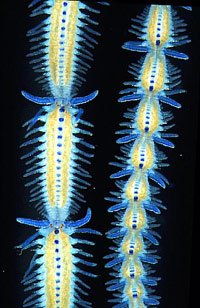Creature
Feature:
A Polycheate (Worm) Detective Story
By Andy Collins,
NOAA, NOS, NWHIMNM -
Education and Outreach Specialist
Leslie Harris, a polycheate (worm) expert from the Natural History Museum of Los Angeles County is onboard our expedition to study the polycheate species we are collecting in our surveys. She is also interested in crustaceans, mollusks, cephalopods, nudibranchs, and a variety of other invertebrates, but onboard she is the worm expert. There is a particular species of worm she finds very interesting that has been found across the tropical Pacific and as an invasive in Southern California harbors. She is very curious to see if it is found here at French Frigate Shoals. I spoke with her about her worm detective story.
 |
Myrianida pachycera. Photo: Leslie Harris. |
About
15 or 20 years ago, in the harbors of Southern California,
I found this particular species of polycheate and knew
immediately that it didnít match any worm I had seen before
in 20 years of working on the NW Pacific coast of North
America, so I started looking around in the literature
and finally identified it as Myrianida
pachycera (Augener 1913). This was very exciting to me at the time and was the start of my interest in invasive species. The place where this animal was first described was SW Australia. So I had this worm described from Australia and it was showing up for the first time, as far as anyone knew, in Southern California. Since then I have found it repeatedly, but always in harbors, and always in association with a particular yellow sponge, so I am quite sure it arrived through fouling on ships.
Looking further into the history of the animal, I found that it was described under another name from Japan in 1933 as Autolytus
purpuriemaculata (Okuda, 1933). In 1965 it was described in Hawaii as Myrianida
crassicirrata (Hartman-Schroeder, 1965). It has been found in other places throughout the tropical Pacific and there is one record from Florida, so it is getting around quite a bit in tropical areas. I am very curious to see if we are going to find it up here. Because of the lack of shipping in the area around French Frigate Shoals and the other Northwestern Hawaiian Islands, if it is here then it is likely to be native to the area and not introduced. So the next question is: Is it a widespread species throughout the tropical Pacific, or did it start off in one area and get transported from place to place? Through genetic analysis we may be able to figure that out.
 |
Assexual reproduction by budding.
Photo by Leslie Harris. |
This particular animal is also interesting to me because it is in the family Syllidae,
a family that I do a lot of research on. The family is particularly fascinating because it has a wide variety of reproductive modes. This
particular animal has alternation of sexual and asexual generations.
If you look at the picture on the left there is the parent animal, and then coming off behind it is a chain of what we call stolons, which
are asexually produced juveniles. The smallest ones are next to the body
of the parent and the largest ones are at the end of the chain, and when they
are large enough they will break off from the chain and live
on their own. The parent that is producing these individuals is asexual, but
the animals that are budding off will either be all male or
all female. Once they have detached to live independently they will produce eggs and sperm, and at the appropriate time, swim up in the
water column and swarm, then burst open. The eggs and sperm are released
to undergo external fertilization. The animals that are produced from that process are asexual, so there is this alternation of asexual and
sexual. Itís just amazing the variety of reproductive modes in this family
of worms.
Studying potentially invasive species is like a great puzzle. Even though we may be able to look at an animal and say with a good deal of certainty that it is not native to an area, we donít necessarily know where it originated. Trying to figure out how an animal spreads from one place to another and where it originated is fascinating for me. In the case of this worm we are not sure whether it originated from, Japan, Australia, or Hawaii, but finding it in the Northwestern Hawaiian Islands would certainly lead us to believe that it is at least native to Hawaii since there are few paths for introduction to a place such as French Frigate Shoals.
So far we have not found this worm in our surveys, but we still have ten more days to go and we may find it yet.
*All images and information from French Frigate Shoals are provided
courtesy of the Northwestern Hawaiian Islands Marine National Monument,
Hawaiian Islands National Wildlife Refuge, the Northwestern Hawaiian
Islands State Marine Refuge, and NOAA's Pacific Islands Fisheries
Science Center in accordance with permit numbers NWHIMNM-2006-015,
2006-01, 2006-017, and DLNR.NWHI06R021 and associated amendments.
Click
on one of the following areas to follow the expedition.
Ship
Logs:
Day-by-day
activities of the ship: what research is being done that
day, what the weather is like, what's for dinner, etc.
Journals:
Daily
or semi-daily personal journal entries by the particpants
in the expedition. These journals do not necessarily reflect
the positions of any of the agencies connected with this
project.
Interviews:
Interviews with expedition participants, scientists,
vessel crew, educators, etc.
Features:
Highlights or special information such as interesting
discoveries or related research.